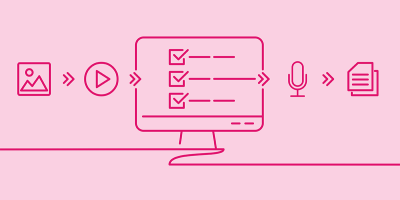File Naming Best Practices for Digital Asset Management

Nate Holmes
Sr. Manager, Product Marketing
The names of people, places, and things help us understand and navigate the world. These terms help us identify exactly what we’re looking for. The same holds true in digital environments, where descriptive names allow files to be easily understood, located, and retrieved. That’s why many teams use file naming conventions to make their content easily locatable.
Everything from file folder directories to collaborative work tools are more effective if their digital files have meaningful and appropriate names. So it should come as no surprise that strong file naming conventions also help maximize the power and efficiency of a digital asset management (DAM) platform.
In this article, we’ll explore file naming conventions best practices that help teams ensure that their content is organized and findable.
What are file naming conventions?
| File naming conventions are frameworks for naming digital files in a descriptive, accurate, and consistent manner. They provide valuable information about what the file contains and how it relates to others in the system so that opening the file isn’t the only way to understand what is inside. Further, they support file organization, findability, and preservation. |
Although there are limitless ways to design a file naming convention system, it must be agreed upon and diligently used by everyone who is creating, locating, or using the files. So in any file naming convention strategy, consistency is key!
And when considered holistically, file naming conventions can be used to drive automation across marketing technology (martech) tools. For example, you can use metadata mapping in your DAM system to tag content upon upload with specific metadata values, based on an asset’s file name. Or, you can use file naming conventions to quickly identify key information, like photographer, brand name, or product line. These file naming best practices for digital asset management eliminate manual steps — and can open up a world of organizational opportunities.
Enforcing digital asset management file naming conventions
It’s common for teams to work differently and adhere to different best practices. But when you’re leveraging a tool like a DAM platform that’s used across the company for multiple purposes, consistency will be your best friend. That’s why it’s important to understand your user base and set up your solution to be able to scale. Many companies achieve this by having a dedicated DAM admin to look at the system holistically and keep it running smoothly.
File names can include any information that will make each file unique and easily distinguished from one another. But as we mentioned earlier, the key to making them effective is consistency. It’s essential to document your naming conventions and keep this documentation in a place where all system users can access it. Additionally, you’ll want to establish training materials to educate new employees on your naming conventions — and consider offering a refresher course too.
It’s also helpful to keep in mind that file naming needs will likely change over time. So it’s important to have a process that can scale with evolving business priorities.
When drafting or reconfiguring your file naming conventions, keep in mind elements that are often captured in file names, including:
- A unique identifier: project name, number, or creator; or product ID or SKU/ASIN
- Date: including the year, month, and day
- Location: city, region, or country, etc.
- Description: what the file is or about
Although there are many ways to build a file naming strategy, there are several best practices that are important to follow:
1. Select your descriptive elements wisely
Use terms that will be easily understood by your users now, and well into the future. Look for meaningful, commonly used terms within your organization to get started. Consider acronyms used for product names, department numbers, or important information captured in your enterprise resource planning (ERP) system. Keep in mind, though, the longevity of this information. Using information like an employee’s name or initials might be meaningful in the moment, but what happens when they leave the company?
2. Use YYYMMDD / YYMMDD or YYY Month DD for dates
Using dates can be tricky, especially if your company is global. Take this into consideration when selecting your date format. Using a numerical date format can be incredibly helpful for chronological sorting — especially if the date is located at the beginning of the file — but could cause confusion across international audiences if MMDD is used over DDMM. Including the determined date format in your file convention documentation, DAM guidelines, and training resources will encourage alignment across teams.
3. Keep it concise
If possible, avoid using small words, like a, the, of, and to, and use standard abbreviations. These filler words take up space and, depending on how many characters are visible, could force users to take extra clicks in order to see the full name.
4. Avoid special characters
Characters such as ! ? @ # $ ~ ^ & % * ` ; < > , ' " | [ ] and ( ) should not be used because they can have a special meaning to the operating system. Using these characters can also interfere with automation options, so it’s best to avoid them.
5. Decide if spaces are permitted
Although there isn’t a golden rule around the use of spaces, many sources (such as Harvard and the University of Aberdeen) recommend using hyphens, underscores, or no separation at all, instead. Many DAM systems also have advanced search and sorting options that could function differently based on spaces and hyphens. Work with your DAM vendor to understand the full scope of each use case to inform your space-hyphen decision.
6. Use title case
Capitalize just the first letter of all principal words. This can help users understand the file name at a glance — especially if you’re not using spaces or hyphens.
7. Include version numbers
Not surprisingly, files with the same name can be easily confused. That’s why it’s important to have unique qualifiers to distinguish them. This is true even when it’s a different version of the same file. If files will have multiple iterations, using V1, V2, V3, V3.1 etc. will differentiate their names and provide an easy way to identify the most recent file at a glance. However, many DAM solutions offer version control features that could make this file naming option redundant, so it’s important to understand all the available functionality before settling on a naming convention.
8. Create a guide
Document the rules in your file naming framework, along with samples. Make the guide readily available to everyone that uses the files, and offer training if necessary. This will help ensure that your strategy is consistently applied and understood by all users. Including this guide in new-hire training and offering ad hoc training opportunities will also help keep things running smoothly.
9. Consider where the name will appear
File names might appear externally in locations such as a portal, embed code, or share link. Consider where your files will be used and how the naming convention will be interpreted by someone outside of your company.
Here are a few examples of what effective file names look like:
20220501_JaneDoeDirectMailFlyer_v9.esp
2022-01-30_ChicagoWorkshop_NameBadges.jpg
SKU897645_Packaging_Target_20220115_Final.pdf
Start organizing today
How files are named and organized has a huge impact on their likelihood to be found, used, and preserved. In a DAM platform, the file name is an essential piece of metadata that supports system organization, drives search performance, and helps ensure that shared assets are easily understood. A meaningful, consistent file naming methodology, along with defined guidelines, will go a long way in system usability and adoption.
Learn more about Acquia DAM (Widen) the core features of a DAM solution — and when you’re ready, take a tour of ours in action. If you have questions, we’re always here to help, too. Just get in touch.

Note: This article was originally published on Widen.com.


